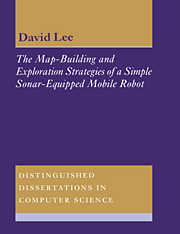Crossref Citations
This Book has been
cited by the following publications. This list is generated based on data provided by Crossref.
Hongbin Zha
Tanaka, K.
and
Hasegawa, T.
1997.
Detecting changes in a dynamic environment for updating its maps by using a mobile robot.
Vol. 3,
Issue. ,
p.
1729.
Harris, K.D.
and
Recce, M.
1997.
Neural model of a grid-based map for robot sonar.
p.
34.
Kotani, Shinji
Nishikawa, Kazuhiro
and
Mori, Hideo
1997.
Empirical learning in mobile robot navigation.
Advanced Robotics,
Vol. 12,
Issue. 4,
p.
317.
Lee, David
and
Recce, Michael
1997.
Quantitative Evaluation of the Exploration Strategies of a Mobile Robot.
The International Journal of Robotics Research,
Vol. 16,
Issue. 4,
p.
413.
Mori, Hideo
Kotani, Shinji
and
Kiyohiro, Noriaki
1998.
Assistive Technology and Artificial Intelligence.
Vol. 1458,
Issue. ,
p.
221.
Cahut, L.
Valavanis, K.P.
and
Delic, H.
1998.
Sonar resolution-based environment mapping.
Vol. 3,
Issue. ,
p.
2541.
Tanaka, K.
Hongbin Zha
and
Hasegawa, T.
1998.
Planning observation positions for a mobile robot to update incomplete maps of indoor environments.
Vol. 2,
Issue. ,
p.
899.
Kleeman, L.
1999.
Fast and accurate sonar trackers using double pulse coding.
Vol. 2,
Issue. ,
p.
1185.
Tanaka, K.
Zha, H.
and
Hasegawa, T.
1999.
Observation planning for map updating tasks by predicting changes in environments.
Vol. 1,
Issue. ,
p.
311.
Yilma, B
and
Seif, M.a
1999.
Behavior-based artificial intelligence in miniature mobile robot.
Mechatronics,
Vol. 9,
Issue. 2,
p.
185.
Kleeman, Lindsay
1999.
Real time mobile robot sonar with interference rejection.
Sensor Review,
Vol. 19,
Issue. 3,
p.
214.
Blanes, F.
Benet, G.
Simo, J.F.
and
Perez, P.
1999.
Enhancing the real-time response of an ultrasonic sensor for map building tasks.
Vol. 3,
Issue. ,
p.
990.
Romero, Leonardo
Morales, Eduardo
and
Sucar, Enrique
2000.
Advances in Artificial Intelligence.
Vol. 1952,
Issue. ,
p.
389.
Barbera, H.M.
Skarmeta, A.G.
Izquierdo, M.Z.
and
Blaya, J.B.
2000.
Neural networks for sonar and infrared sensors fusion.
p.
WEB4/18.
Fujimori, A
Ogawa, Y
and
Teramoto, M
2000.
Navigation of a sonar-equipped mobile robot with real-time local map building.
Proceedings of the Institution of Mechanical Engineers, Part I: Journal of Systems and Control Engineering,
Vol. 214,
Issue. 5,
p.
319.
Toledo, F.J.
Luis, J.D.
Tomas, L.M.
Zamora, M.A.
and
Martinez, H.
2000.
Map building with ultrasonic sensors of indoor environments using neural networks.
Vol. 2,
Issue. ,
p.
920.
Romero, Leonardo
Morales, Eduardo
and
Sucar, Enrique
2000.
MICAI 2000: Advances in Artificial Intelligence.
Vol. 1793,
Issue. ,
p.
158.
Scheinerman, E.R.
2001.
Determining planar location via complement-free de Brujin sequences using discrete optical sensors.
IEEE Transactions on Robotics and Automation,
Vol. 17,
Issue. 6,
p.
883.
Martinez, H.
Zamora, M.A.
and
Skarmenta, A.G.
2001.
Navigation of a mobile robot with fuzzy segments.
Vol. 3,
Issue. ,
p.
586.
Kazer, John F.
and
Sharkey, Amanda J. C.
2001.
Emergent Neural Computational Architectures Based on Neuroscience.
Vol. 2036,
Issue. ,
p.
507.



